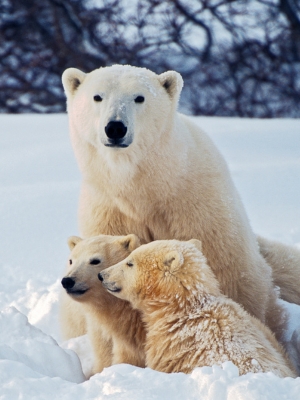Throughout the progression of modern human history, it seems that two camps of drastically opposing views on wildlife have developed: one group, which demands that wildlife be protected from people (mainly young, progressive city-dwellers), and the second group (mostly agriculturalists and livestock producers), which demands that people and commercially bred animals be protected from wildlife.
Perhaps counterintuitive to most, many wildlife protection agencies in the U.S. began with the initial mission of killing all wild animals that threatened human safety and agricultural endeavors; not to protect the wildlife native to these lands. In fact, the U.S. Fish and Wildlife Service (USFWS) still attributes the “success” of the North American Model of Wildlife Conservation to hunting, trapping, and fishing.
This model of wildlife “conservation” has enabled legislative bodies to make decisions about wild animal population management without using science to inform these decisions.
The North American Model of Wildlife Conservation uses the argument that establishing the first hunting regulations has helped advocate for and increase the protection of wildlife habitat. This emphasis on human-driven management and thus ownership of wildlife also drives the model’s two basic principles: “that our fish and wildlife belong to all North American citizens and are to be managed in such a way that their populations will be sustained forever,” supported by the outdated but prevalent core belief that killing animals functions as wildlife “conservation.”
Antiquated Beliefs about Wildlife Still Inform Official Wildlife Policy
Stemming from these problematic beliefs, the USFWS actively glorifies lethal wildlife management methods. For example, on the Mississippi Department of Wildlife, Fisheries, and Parks website, they praise these practices by proclaiming that: “Today, it is still the hunters and anglers that support the conservation efforts that benefit wildlife populations and habitats in support of our uniquely successful conservation model.”
This model of wildlife “conservation” has enabled legislative bodies to make decisions about wild animal population management without using science to inform these decisions. As a result, the USFWS has been sued in the past for removing species threatened with extinction from legal protection (delisting) that science indicated needed the protection. Some examples of species that became delisted without or contrary to proper scientific support include wolves, northern spotted owls, red tree voles, bison, and grizzly bears, among others.
Wolf Conservation Epitomizes This Harmful and Outdated Notion of Wildlife Management
Wolves are the most prominent example of the North American Model of Wildlife Conservation model’s failures. Before the first European settlers, a quarter of a million wolves were thriving in the U.S. After the arrival of the settlers, wolves were heavily hunted, which resulted in severely isolated populations. When wolves were listed as Endangered in 1974, their numbers began to recover.
In 2011, Congress delisted gray wolves in the Northern Rocky Mountain states (Idaho and Montana); this was the first time a legislative body had delisted a species and opened the door to subsequent species delisting this way. In 2019, the Trump administration delisted gray wolves nationwide (except for Mexican wolves in Arizona and New Mexico). Directly following the delisting, over 200 wolves were killed in just 60 hours in one of the first hunts after wolf protections were removed.
Further, controversial laws in some states allowed the slaughtering of up to 90% of wolf populations, even permitting extreme slaughtering methods like snares and bounties. As a result, the decision to delist wolves galvanized anti-wolf groups to unleash unimaginable cruelty, as seen most recently in the horrific news story that described a man in Wyoming who chased a wolf down on his snowmobile, taped the mouth of a wolf shut, and dragged him through a bar before killing him. The punishment for this grotesque act of cruelty? The Wyoming Game and Fish Department fined the man $250 for possession of a live wild animal. In 85% of Wyoming in what is known as the “predator zone,” wolves, coyotes, red foxes, raccoons, porcupines, jack rabbits, and stray cats can be legally killed using any method, including hounding, baiting, neck snares, leg-hold traps, shooting from an aircraft, and M-44 “cyanide bombs.”
In 2022, a federal judge found that the delisting that occurred during the Trump administration was not supported by science and reversed the wolf delisting but did not include wolves in Northern Rocky Mountain states (the population that potentially needed protections the most). In February 2024, the U.S. Fish and Wildlife Service announced that they would support a long-term approach to the conservation of gray wolves and would develop (for the first time) a National Recovery Plan under the Endangered Species Act (ESA) for gray wolves in the lower 48 states. Unfortunately, the USFWS announcement did not, however, make any changes to the legal status of gray wolves in the U.S. On April 8, 2024, the USFWS was sued by several wildlife organizations to restore protection for wolves in the Northern Rockies.
In attempts to justify wolf hunts, many argue that they pose threats to livestock, deplete wild prey populations, and threaten human safety; yet there is no scientific basis for any of these claims. Data confirms that livestock losses due to wolves and other native carnivores are rare; using government data, the Humane Society of the United States (HSUS) found that losses to cattle and sheep caused by wolves, cougars, and grizzly bears amounted to less than 1% of those domestic animal inventories in every state containing those wildlife species. Also, there is no record of a wolf killing a human in the lower 48 states.
In attempts to justify wolf hunts, many argue that they pose threats to livestock, deplete wild prey populations, and threaten human safety; yet there is no scientific basis for any of these claims.
It is, in fact, believed that hunting wolves may increase livestock deaths. Hunting likely kills leaders of wolf packs, which removes hunting experience and basic survival knowledge from future generations, ultimately leaving behind unstable wolf packs that are more likely to disperse and prey on livestock than to hunt wild prey.
Nonlethal Methods of Wildlife Management Are Often More Effective
Many nonlethal and highly effective tools exist to address issues of predator-livestock conflict; several non-lethal predator control methods have been demonstrated to be more effective in preventing carnivore predation on livestock than lethal control methods. Some lethal control methods, including government culling and regulated hunting, were found to increase instances of livestock predation in some cases.
Born Free USA works with partners to increase wildlife protection via the strengthening of flagship legislation like the Endangered Species Act, as well as fighting for the introduction of new laws to protect wild animals in their natural habitat from harms such as trophy hunting, killing contests, and trapping. You can learn more about our work here.
Keep Wildlife in the Wild,
Devan
Dear Reader,
We are a nonprofit committed to wildlife conservation, welfare, and rescue. Making resources free and widely distributed, like our news items, is an important part of our mission. If you found this article helpful, enjoyable, or enlightening, please donate to help keep these resources available, and Keep Wildlife In The Wild.
Thank You,
The Born Free USA Team

 Dear Reader,
Dear Reader,